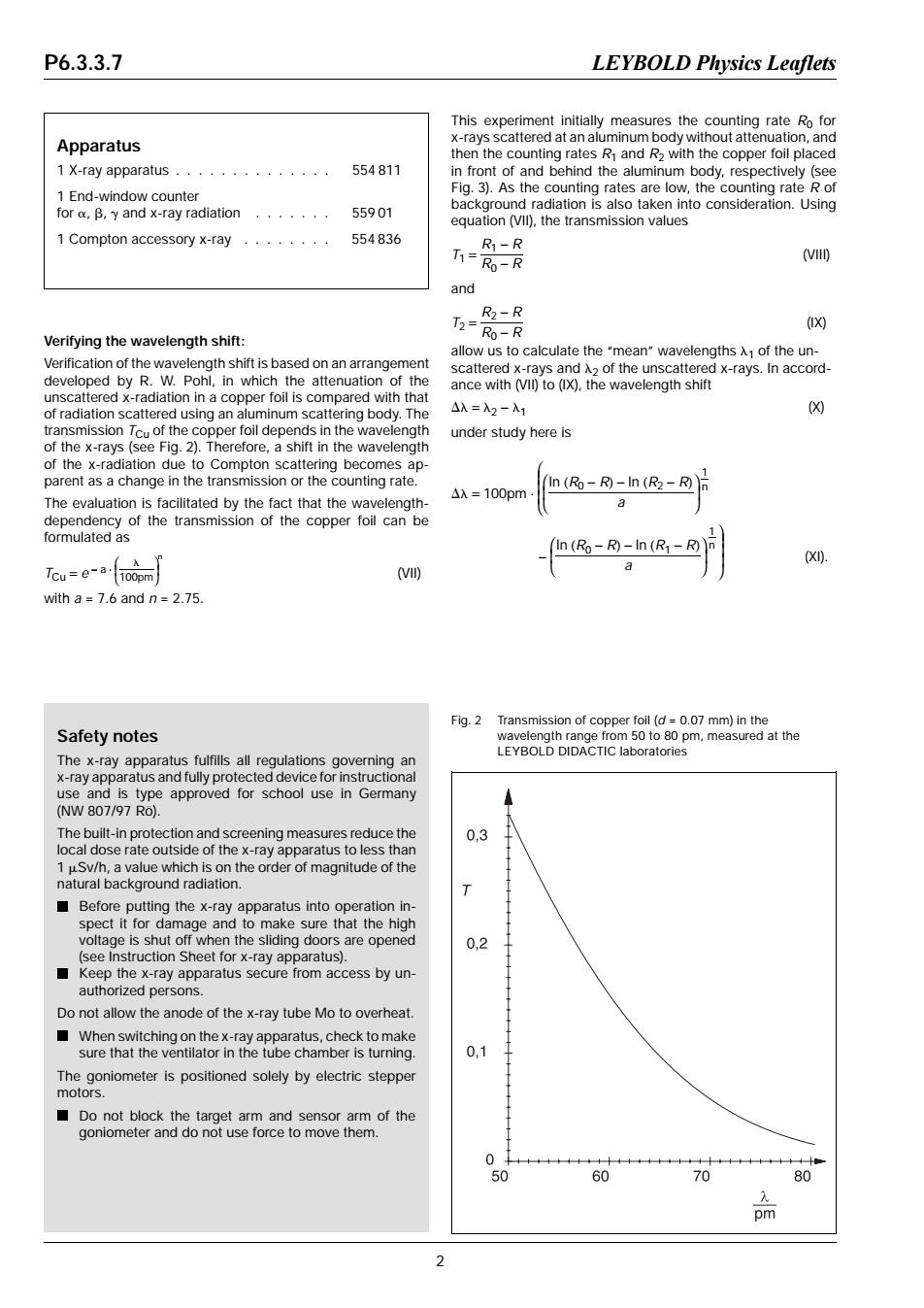正在加载图片...

P6.3.3.7 LEYBOLD Physics Leaflets This experiment initially measures the counting rate Ro for x-rays scattered at an aluminum body without attenuation,and Apparatus then the counting rates R and R2 with the copper foil placed 1X-ray apparatus.············· 554811 in front of and behind the aluminum body,respectively(see 1 End-window counter Fig.3).As the counting rates are low,the counting rate R of fora,B,y and x-ray radiation·.·.··. 55901 background radiation is also taken into consideration.Using equation (VIl),the transmission values 1 Compton accessory x-ray..·.···· 554836 R1-R T1=Ro-R (I0 and T2= R2-R Verifying the wavelength shift: Ro-R (X) allow us to calculate the "mean"wavelengths1 of the un- Verification of the wavelength shift is based on an arrangement scattered x-rays and A2 of the unscattered x-rays.In accord- developed by R.W.Pohl,in which the attenuation of the ance with (VIl)to(IX),the wavelength shift unscattered x-radiation in a copper foil is compared with that of radiation scattered using an aluminum scattering body.The △λ=2-入1 ☒ transmission Tcu of the copper foil depends in the wavelength under study here is of the x-rays (see Fig.2).Therefore,a shift in the wavelength of the x-radiation due to Compton scattering becomes ap- parent as a change in the transmission or the counting rate. (In (Ro-R)-In (R2-R) △x=100pm n The evaluation is facilitated by the fact that the wavelength- dependency of the transmission of the copper foil can be formulated as (In (Ro-R)-In (R1-R) (AP (X0. Tcu=e-a100pm) (VII) with a =7.6 and n=2.75. Fig.2 Transmission of copper foil (d=0.07 mm)in the Safety notes wavelength range from 50 to 80 pm,measured at the The x-ray apparatus fulfills all regulations governing an LEYBOLD DIDACTIC laboratories x-ray apparatus and fully protected device for instructional use and is type approved for school use in Germany (NW807/97Ro). The built-in protection and screening measures reduce the 0,3 local dose rate outside of the x-ray apparatus to less than 1 uSv/h,a value which is on the order of magnitude of the natural background radiation. 入 Before putting the x-ray apparatus into operation in- spect it for damage and to make sure that the high voltage is shut off when the sliding doors are opened 0,2 (see Instruction Sheet for x-ray apparatus). Keep the x-ray apparatus secure from access by un- authorized persons. Do not allow the anode of the x-ray tube Mo to overheat. When switching on the x-ray apparatus,check to make sure that the ventilator in the tube chamber is turning. 0,1 The goniometer is positioned solely by electric stepper motors. Do not block the target arm and sensor arm of the goniometer and do not use force to move them. 0 50 60 70 80 pm 2Verifying the wavelength shift: Verification of the wavelength shift is based on an arrangement developed by R. W. Pohl, in which the attenuation of the unscattered x-radiation in a copper foil is compared with that of radiation scattered using an aluminum scattering body. The transmission TCu of the copper foil depends in the wavelength of the x-rays (see Fig. 2). Therefore, a shift in the wavelength of the x-radiation due to Compton scattering becomes apparent as a change in the transmission or the counting rate. The evaluation is facilitated by the fact that the wavelengthdependency of the transmission of the copper foil can be formulated as TCu = e − a ⋅ l 100pm n (VII) with a = 7.6 and n = 2.75. This experiment initially measures the counting rate R0 for x-rays scattered at an aluminum body without attenuation, and then the counting rates R1 and R2 with the copper foil placed in front of and behind the aluminum body, respectively (see Fig. 3). As the counting rates are low, the counting rate R of background radiation is also taken into consideration. Using equation (VII), the transmission values T1 = R1 − R R0 − R (VIII) and T2 = R2 − R R0 − R (IX) allow us to calculate the “mean” wavelengths l1 of the unscattered x-rays and l2 of the unscattered x-rays. In accordance with (VII) to (IX), the wavelength shift Dl = l2 − l1 (X) under study here is Dl = 100pm ⋅ ln (R0 − R) − ln (R2 − R) a 1 n − ln (R0 − R) − ln (R1 − R) a 1 n (XI). Apparatus 1 X-ray apparatus . . . . . . . . . . . . . . 554 811 1 End-window counter for a, b, g and x-ray radiation . . . . . . . 559 01 1 Compton accessory x-ray . . . . . . . . 554 836 Safety notes The x-ray apparatus fulfills all regulations governing an x-ray apparatus and fully protected device for instructional use and is type approved for school use in Germany (NW 807/97 Rö). The built-in protection and screening measures reduce the local dose rate outside of the x-ray apparatus to less than 1 mSv/h, a value which is on the order of magnitude of the natural background radiation. Before putting the x-ray apparatus into operation inspect it for damage and to make sure that the high voltage is shut off when the sliding doors are opened (see Instruction Sheet for x-ray apparatus). Keep the x-ray apparatus secure from access by unauthorized persons. Do not allow the anode of the x-ray tube Mo to overheat. When switching on the x-ray apparatus, check to make sure that the ventilator in the tube chamber is turning. The goniometer is positioned solely by electric stepper motors. Do not block the target arm and sensor arm of the goniometer and do not use force to move them. Fig. 2 Transmission of copper foil (d = 0.07 mm) in the wavelength range from 50 to 80 pm, measured at the LEYBOLD DIDACTIC laboratories P6.3.3.7 LEYBOLD Physics Leaflets 2